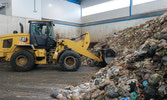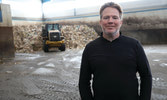By Jeff Tribe
StormFisher Vice-President of Development, Brandon Moffatt, has heard more than once about one person’s trash being another’s treasure.
“That’s very fair,” he allowed, adding the other metaphor he catches frequently is “we’re a dairy cow.”
Officially, StormFisher “develops and operates facilities that recycle food, waste, energy and water in an environmentally and economically-sustainable manner.” But a company which takes its highly-recognizable and memorable name from the founder’s observation that “after a storm is a good time to go fishing” combined with advanced technology being imported into the United States (rather than the other way around), has enough confidence and sense of humour to be good with “trash from treasure” or “dairy cow”.
“That’s a good one too,” Moffatt smiled.
A University of Waterloo renewable energy and food waste graduate who grew up on a farm near Watford, Moffatt was recruited to StormFisher from a consulting company in 2006. Liking what he saw was enough for Moffatt to buy in as a partner in 2009. In very broad terms, the company produces energy and fertilizer from municipal, industrial, commercial and institutional organic waste.
“If it should have, could have or would have been food, we’re good,” Moffatt summed up succinctly.
StormFisher uses a two-stage process beginning with impurity removal and primary processing at its Drumbo Resource Recovery Centre. Its location combines access to source material intake and a quality labour pool with convenient connection to the 401.
Municipal source separated green bin organics and packaged food waste is essentially spread out in order to identify and remove larger physical objects (a metal trailer hitch for example) with the potential to either damage or jam the two hammermills which break product down into a more optimal form for stage two. Belly screens in the hammermills separate and divert smaller items such as plastic table utensils. The two production lines are capable of handling a limited amount of materials like oyster shells, for example, although not a full truckload. One memorable load of athletic uniforms, for example, was also an outright reject.
“No, we can’t handle football jerseys,” Moffatt smiled.
The process yields three main categories of product, beginning with clean organics ready to be transported onward to anaerobic digesters including StormFisher’s London-based and other related biogas operations, as well as third-party digesters. Residuals are routed to a landfill, and recyclables, shipping and food packaging, reclaimed where possible from industrial food items. “Cardboard, pallets, things like that.”
Odour control is a crucial part of operations, says Moffatt, vital to being a “good industrial citizen” and maintaining community support.
“We need to do a really good job to make sure we are not a nuisance.”
The plant operates under negative atmospheric pressure, pulling air inward, thereby controlling and compartmentalizing odours for treatment with a thermal oxidizer. Its operational temperature of 800 degrees Celsius has proven more successful than simple filters during summer heat.
“So we ensure we don’t have any issues for our neighbours,” says Moffatt.
Primarily processed organics are transported to StormFisher’s biogas plant located a short drive off the 401, south of London. In very basic terms, targeted anaerobic digestion utilizes a natural bacteria-driven process within sealed tanks, producing renewable natural gas. Digested organic materials are then used as Canadian Food Inspection Agency-registered granule and liquid fertilizer which is sold to local cash croppers.
“Who use it as a replacement for synthetic,” said Moffatt of a 3-3-1 material valued as good organic matter with beneficial carbon-to-nitrogen ratios and levels of micro-nutrients.
“Iron and sulphur and other things like that you might not get with a synthetic fertilizer.”
StormFisher organic fertilizer is used for corn and wheat in particular, says Moffatt.
“They like the anaerobic in the product because it’s readily available.”
A very basic example of the closed loop StormFisher’s process generates is fertilizer supporting crop production to feed beef cattle, which ultimately are processed at the Better Beef plant in Guelph. By-products from that location are repurposed through anaerobic digestion in London, resulting in both energy and fertilizer which is cycled back through the original farm in a win/win/win situation.
Biogas created through the anaerobic digestion process can either be used to generate electricity or refined further for use as an external fuel source. Resultant refined product is injected into a pipeline either for sale, or use in StormFisher’s own transportation trucks which roll down the road powered essentially by waste.
The process goes beyond carbon neutral says Moffatt into carbon negative fuel production. “Rather than just reducing greenhouse gasses, we are a carbon sink. It’s one of the only carbon-negative fuels in North America.”
StormFisher’s approach presents significant advantages from an environmental perspective, creating useful and crucially, saleable items from waste. The “feel good” approach symbiotically benefits both rural and urban areas, creating a viable repurposing option as well as positive bottom line potential for the company and its shareholders. StormFisher’s fees to accept waste material are very competitive with landfill tipping rates, says Moffatt, its fertilizers are in demand and natural gas produced in its environmentally-positive manner commands a premium over its fossil equivalent.
“I’m in the business frankly, to make money. Otherwise we don’t get the privilege of doing what we do.”
StormFisher’s $60-million London biogas plant opened in 2012, another $20-million was put into Drumbo’s primary processing facility in 2019/2020. The $80-million total investment has created significant area spinoffs along with 50 direct jobs, 10 in Drumbo and 40 in London, some of which also support Drumbo’s operation.
“It’s not just a line model that puts things back in a landfill, it’s money that keeps going round and round to support these local communities,” says Moffatt. “It’s kind of a bit of what defines us.”
Beyond environmentally-friendly electricity and natural gas, the concept has also generated considerable interest throughout North America. It has been Moffatt’s experience through conventions in California, for example, that StormFisher’s approach is leading edge, and in demand. “Because frankly, we are good at what we do.”
The London and Drumbo facilities represent the company’s core infrastructure, however it has been successful in exporting technological and operational direction to sites in both Michigan and New York State.
“A key part of this good news story is the build out of this infrastructure in Ontario is leading to other opportunities in other parts of North America,” says Moffatt.
In conclusion, the concept of reusing rather than wasting materials is a timeless tenet of rural life, but the time for StormFisher’s modern interpretation has clearly come. “We need more of this infrastructure in the province,” Moffatt concluded. “The challenge is where and how to build it out.” ◊



